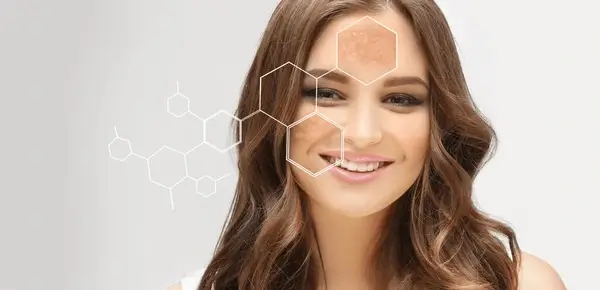Skin spots are vulnerable to ageing and environmental factors. Exposure to sunlight, acne formation and other external factors can cause spots on the skin. These spots can negatively affect individuals’ social lives as well as causing aesthetic problems. Can acne and sun spots on our faces be treated? Of course, in this article, we will provide information about the causes of skin spots, treatment methods, and prevention strategies.

Causes of Skin Discolouration
Skin spots are caused by an uneven distribution of a pigment called melanin in the skin. Melanin is a substance that gives our skin its colour, and excessive production of it can cause various spots to form. Skin spots can be classified into several main categories:
- Sunspots: These spots, which are caused by exposure to UV rays, usually increase over time. In individuals who do not use sunscreen for long periods of time, the skin prepares the ground for the formation of spots by increasing melanin production.
- Pregnancy spots (melasma): These spots, which are usually caused by hormonal changes during pregnancy, can also occur in men. Stress and hormonal imbalances trigger melanin production.
- Freckles These spots, which increase in skin types sensitive to sunlight, especially in summer months, usually appear on areas such as cheeks, nose and forehead.
- Fungal Infections: Some fungal infections can cause discolouration of the skin.
- Allergic Reactions: Some medications or topical creams may cause hyperpigmentation of the skin.
How to Get Rid of Skin Blemishes?
The most effective treatment method for skin spots varies depending on the cause of the spot. While special creams are generally preferred for melasma, laser treatment may be more effective for other types of spots. A specialist dermatologist should correctly diagnose the origin of skin spots and determine the most appropriate treatment method.
Treatment options include:
- Laser Treatments: Fractional and non-fractional lasers are used to target skin blemishes. The laser beam targets pigment cells and breaks them down. Different types of lasers may be used depending on skin type and the type of blemish. This treatment usually requires several sessions.
- Mesotherapy: Cell renewal is achieved by injecting spot-removing substances under the skin. This method helps to renew the melanocyte cells in the skin.
- Chemical Peeling: Removes the top layer of skin, allowing new skin cells to form. It is an effective method for treating superficial blemishes.
- Cryotherapy: The freezing process damages the stained cells and triggers the formation of new cells.
- PRP (Platelet-Rich Plasma): Skin renewal and lightening of blemishes is achieved by injecting platelet-rich plasma obtained from the patient’s blood into the skin.
- Cream Treatments: Creams prescribed by a specialist doctor may be effective for certain types of blemishes. It is recommended that this treatment be continued for at least 12 weeks.
Precautions and Skin Care
The use of sunscreen is very important for preventing skin spots. Before going out in the sun, a cream with an appropriate protection factor should be applied and prolonged exposure to the sun should be avoided. In addition, regular skin care and moisturising should not be neglected for healthy skin.
In conclusion, acne and sun spots on our faces can be treated. However, for these treatment methods to be effective, a correct diagnosis and expert supervision are essential. It should be remembered that every skin type is different and the treatment process must be planned individually. Using sunscreen and regular skin care are critical in preventing the formation of these spots.







